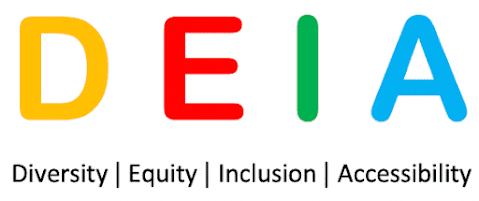What is DEIA?
 |
| Image with the phrase "DEIA" in different bright colors. Below is the text "Diversity | Equity | Inclusion | Accessibility." |
What is DEIA?
What is DEIA?
DEIA is Diversity, Equity, Inclusion, and Accessibility. This represents an approach to make organizations more diverse and provide opportunities for anyone to thrive, despite their race, disability, or age. DEIA aims to welcome anyone despite their backgrounds. DEIA advocates are dedicated to transforming how the workplace treats marginalized people. If it weren't for DEIA advocates, the ADA wouldn't have been passed in 1990.
The Americans with Disabilities Act
Thirty-three years ago, on July 26, 1990, the Americans with Disabilities Act (ADA) was signed into law. This historic civil rights law protects the rights of people with disabilities. It guarantees equal rights and opportunities for people with disabilities. While laws have good intentions, people with disabilities are not provided equal opportunities and frequently face subtle, outright, or egregious discrimination.
The barriers people with disabilities face
People with disabilities face several barriers to entering the workplace and frequently face discrimination and exclusion. To develop an institution of inclusivity, people with disabilities must be represented and embraced at every level.
Disability pride is the concept that disability isn't just a medical condition but a social identity with enriching intersectionality, community, and culture. Disability pride affirms that people with disabilities shouldn't be ashamed of their identity.
We should stop using the term "accommodation." Accommodation feels like an afterthought rather than inclusively providing equitable opportunities for people with disabilities. We should refer to this as "including" people with disabilities, and it needs to go far beyond just "accommodation."
Why DEIA is more crucial than ever
While DEIA is a substantial approach, based on the Harvard Business Review, only about 4% of DEI programs include disability. Even DEI programs designed to address workplace discrimination still fail the disability community, which is why ableism and sanism commonly perpetuate in the workplace.
This statistic is concerning as people with disabilities significantly face barriers in the workforce, like low labor force participation rates, higher unemployment rates, and pay inequality. Some don't even include accessibility in their programs, furthering this belief that accessibility isn't an equity issue.
All the years of shame and stigma, diverting it into the power of pride, are how we can claim our identities matter and are essential. We know they are, but not everyone does. This will also allow us to work together to make a more accessible world welcoming everyone.
Intersectionality
Intersectionality is an "analytical framework for understanding how individuals' various social and political identities result in unique combinations of discrimination and privilege." When addressing disability-related issues, it is essential to seek out perspectives and lived experiences from an array of people because a white woman with a disability will have a different experience from a woman of color with a disability.
Diversity without disability is not diversity.
Suppose your organization or school does not include people with disabilities in your mission, decisions, products, and leadership. In that case, your organization will never be diverse, and ignoring a substantial and vital population segment will only negatively influence your performance and impact. People with disabilities have the right to work and belong to an organization, valuing their contributions and ensuring they have opportunities to thrive as much as everyone else.
In friendship,
Zane Landin
YLC Member, Washington D.C.
Comments
Post a Comment